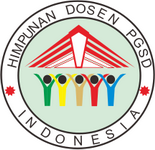AUGMENTED REALITY-BASED LEARNING MEDIA TO IMPROVE STUDENTS' UNDERSTANDING OF THE MATERIAL MY PROVINCE IS PART OF THE REGION OF INDONESIA
DOI:
https://doi.org/10.31949/jcp.v11i2.12606Abstract
The purpose of this study is to investigate how the use of Augmented Reality-based learning media can improve students' understanding of districts/cities and provinces in Indonesia. The background of this study is the low level of students' understanding of districts/cities and provinces in Indonesia. One innovation that has attracted attention is Augmented Reality, which integrates digital elements with physical reality. The methodology applied in this study is a qualitative approach with a case study design. Data were obtained through interviews, observations, and questionnaires distributed to students and teachers. This study involved sixth-grade students of SDN Sangiang II, with a focus on classes studying Pancasila Education regarding districts/cities and provinces as part of the Unitary State of the Republic of Indonesia. The results showed that the use of Augmented Reality-based learning media significantly improved students' understanding of districts/cities and provinces. Students who used Augmented Reality showed an average increase in their scores of 30% compared to students who learned with conventional methods. This study concluded that Augmented Reality-based learning media is an effective tool to improve students' understanding of the material "my province is part of the Unitary State of the Republic of Indonesia."
Keywords:
Learning Media, Augmented Reality, Pancasila EducationDownloads
References
Akçayır, M., & Akçayır, G. (2017). Advantages and challenges associated with augmented reality for education: A systematic review of the literature. Educational Research Review, 20, 1–11. https://doi.org/10.1016/j.edurev.2016.11.002
Alzahrani, N. M. (2020). Augmented reality: A systematic review of its benefits and challenges in e-learning contexts. Applied Sciences (Switzerland), 10(16). https://doi.org/10.3390/app10165660
Anggraeni, S. W., Alpian, Y., Prihamdani, D., & Winarsih, E. (2021). Pengembangan Multimedia Pembelajaran Interaktif Berbasis Video untuk Meningkatkan Minat Belajar Siswa Sekolah Dasar. Jurnal Basicedu, 5(6), 5313–5327. https://doi.org/10.31004/basicedu.v5i6.1636
Braun, V., & Clarke, V. (2019). Thematic analysis revised. Journal of Chemical Information and Modeling, 53(9), 1689–1699.
Carolina, Y. Dela. (2022). Augmented Reality sebagai Media Pembelajaran Interaktif 3D untuk Meningkatkan Motivasi Belajar Siswa Digital Native. Ideguru: Jurnal Karya Ilmiah Guru, 8(1), 10–16. https://doi.org/10.51169/ideguru.v8i1.448
Chairudin, M., Nurhanifah, N., Yustianingsih, T., Aidah, Z., Atoillah, A., & Sofian Hadi, M. (2023). Studi Literatur Pemanfaatan Aplikasi ASSEMBLR EDU Sebagai Media Pembelajaran Matematika Jenjang SMP/MTS. Communnity Development Journal, 4(2), 1312–1318. https://id.edu.assemblrworld.com/
Ghanbaripour, A. N., Talebian, N., Miller, D., Tumpa, R. J., Zhang, W., Golmoradi, M., & Skitmore, M. (2024). A Systematic Review of the Impact of Emerging Technologies on Student Learning, Engagement, and Employability in Built Environment Education. Buildings, 14(9). https://doi.org/10.3390/buildings14092769
Hermawan, A., & Hadi, S. (2024). Realitas Pengaruh Penggunaan Teknologi Augmented Reality dalam Pembelajaran terhadap Pemahaman Konsep Siswa. Jurnal Simki Pedagogia, 7(1), 328–340. https://doi.org/10.29407/jsp.v7i1.694
Ismayani, A. (2020). Membuat Sendiri Aplikasi Augmented Reality. Elex Media Komputindo.
Kumalasari, A. N., & Mochamad Ridwan. (2023). Pengaruh Penggunaan Media Augmented Reality Terhadap Hasil BelajarPassing Sepak Bola Peserta Didik. Jurnal Mahasiswa Pendidikan Olahraga, 3(2), 76–85. https://doi.org/10.55081/jumper.v3i2.904
Li, G., Luo, H., Chen, D., Wang, P., Yin, X., & Zhang, J. (2025). Augmented Reality in Higher Education: A Systematic Review and Meta-Analysis of the Literature from 2000 to 2023. Education Sciences, 15(6). https://doi.org/10.3390/educsci15060678
Miyanti, V., Muhidin, A., & Ardiatma, D. (2023). Implementasi Metode Markerless Augmented Reality Sebagai Media Promosi Home Furnishing Berbasis Android. MALCOM: Indonesian Journal of Machine Learning and Computer Science, 4(1), 71–77. https://doi.org/10.57152/malcom.v4i1.1019
Muali, C., Setyosari, P., Purnomo, & Yuliati, L. (2020). Effects of Mobile Augmented Reality and Self-Regulated Learning on Students’ Concept Understanding. International Journal of Emerging Technologies in Learning, 15(22), 218–229. https://doi.org/10.3991/ijet.v15i22.16387
Nazilah, S., & Ramdhan, F. S. (2021). Augmented Reality Sebagai Media Pembelajaran Untuk Pengenalan Landmark Negara-Negara ASEAN Berbasis Android Dengan Menggunakan Metode Marker Based Tracking. Ikra-Ith Informatika, 5(2), 99–107.
Philippe, S., Souchet, A. D., Lameras, P., Petridis, P., Caporal, J., Coldeboeuf, G., & Duzan, H. (2020). Multimodal teaching, learning and training in virtual reality: a review and case study. Virtual Reality and Intelligent Hardware, 2(5), 421–442. https://doi.org/10.1016/j.vrih.2020.07.008
Pujakesuma, D., Kusuma Ningrum, G. D., & Umami, A. A. (2024). Implementasi Teknologi Augmented Reality Dalam Pengembangan Media Pembelajaran Interaktif Untuk Siswa Kelas X. Jurnal Pembelajaran, Bimbingan, Dan Pengelolaan Pendidikan, 4(6), 4. https://doi.org/10.17977/um065.v4.i6.2024.4
Samala, A. D., Usmeldi, Taali, Ambiyar, Bojic, L., Indarta, Y., Tsoy, D., Denden, M., Tas, N., & Dewi, I. P. (2023). Metaverse Technologies in Education: A Systematic Literature Review Using PRISMA. International Journal of Emerging Technologies in Learning, 18(5), 231–252. https://doi.org/10.3991/IJET.V18I05.35501
Socrates, T. P., & Fatni Mufit. (2022). The Effectiveness of Using Augmented Reality-based Learning Media in Physics Learning: Literature Study. Electrolyte, 1(02), 4–11. https://doi.org/10.54482/electrolyte.v1i02.160
Zaid, M., Razak, F., & Alam, A. A. F. (2022). Keefektifan Media Pembelajaran Augmented Reality Berbasis STEAM dalam Meningkatkan Kualitas Pembelajaran IPA di Sekolah Dasar. Jurnal Pelita: Jurnal Pembelajaran IPA Terpadu, 2(2), 59–68. https://doi.org/10.54065/pelita.2.2.2022.316
Zuniarti, P. P., Yonanda, D. A., & Nahdi, D. S. (2025). Systematic Literature Review: Pengaruh Model Quantum Teaching Berbantu Multimedia Interaktif Terhadap Pemahaman Konsep Siswa. PUSAKA: Journal of Educational Review, 2(2), 65–73. https://doi.org/10.56773/pjer.v2i2.73
Published
How to Cite
Issue
Section
License
Copyright (c) 2025 Dendi Irawan, Devi Afriyuni Yonanda, Ryan Dwi Puspita

This work is licensed under a Creative Commons Attribution-ShareAlike 4.0 International License.
Authors who publish with this journal agree to the following terms:
- Authors retain copyright and grant the journal right of first publication with the work simultaneously licensed under a Creative Commons Attribution License that allows others to share the work with an acknowledgment of the work's authorship and initial publication in this journal.
- Authors are able to enter into separate, additional contractual arrangements for the non-exclusive distribution of the journal's published version of the work (e.g., post it to an institutional repository or publish it in a book), with an acknowledgment of its initial publication in this journal.
- Authors are permitted and encouraged to post their work online (e.g., in institutional repositories or on their website) prior to and during the submission process, as it can lead to productive exchanges, as well as earlier and greater citation of published work (See The Effect of Open Access).


